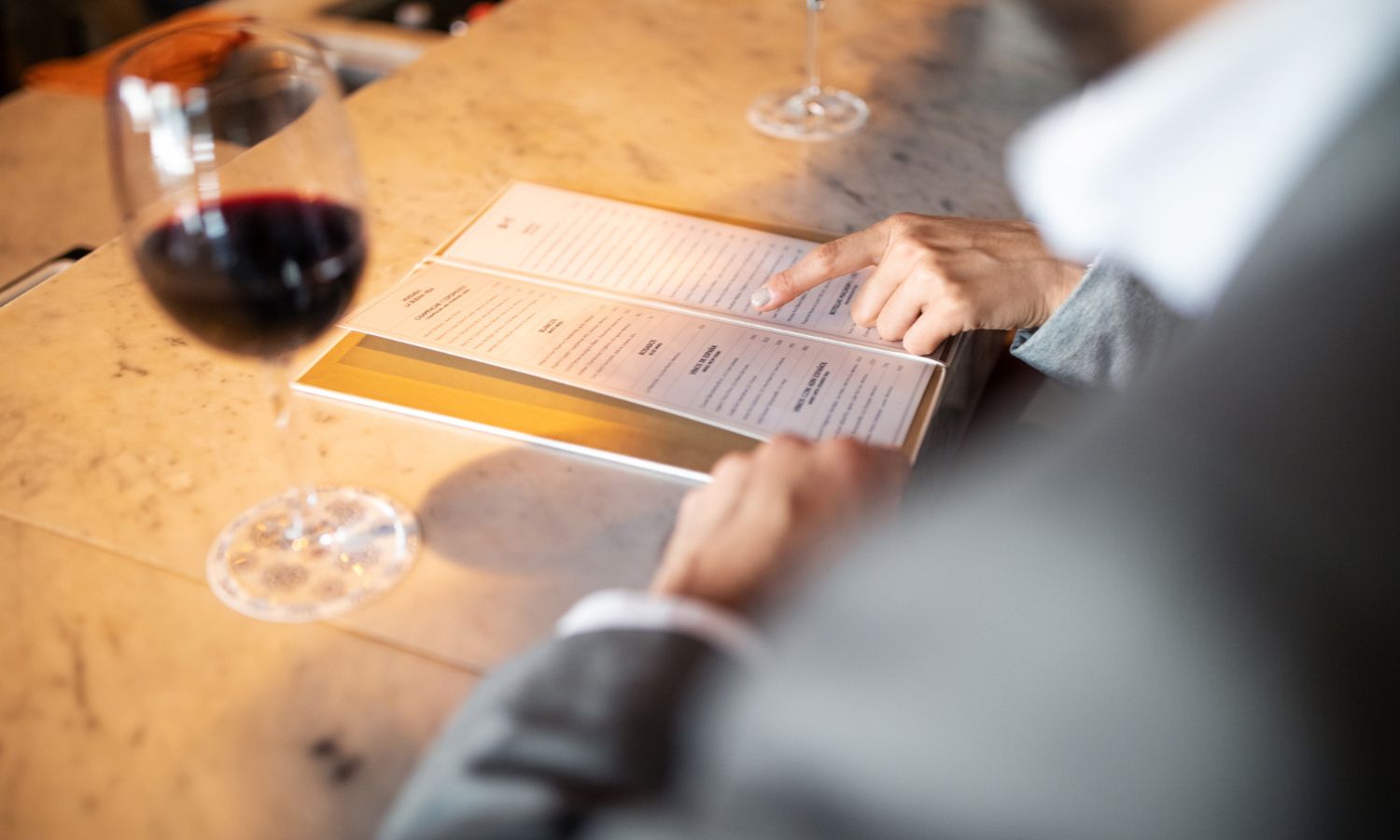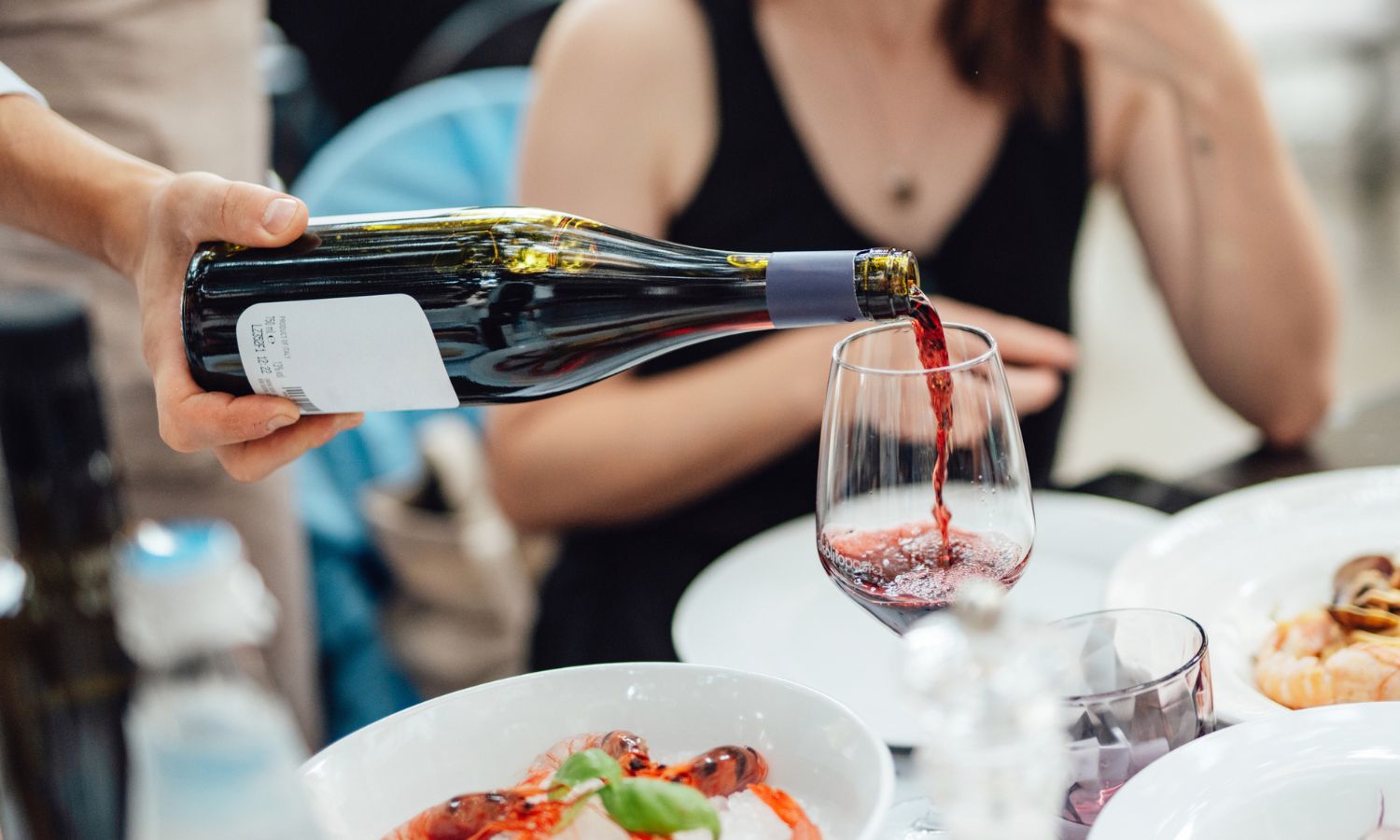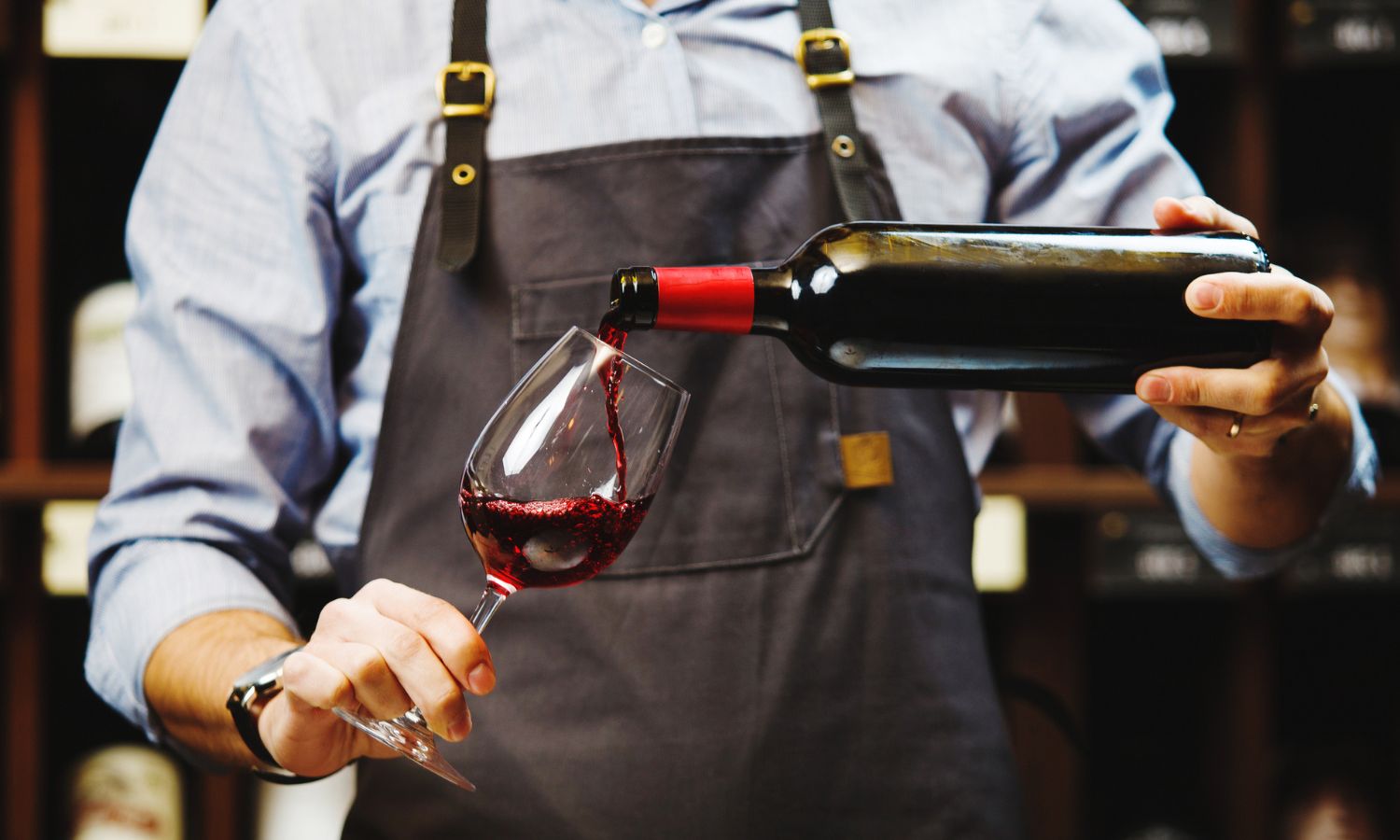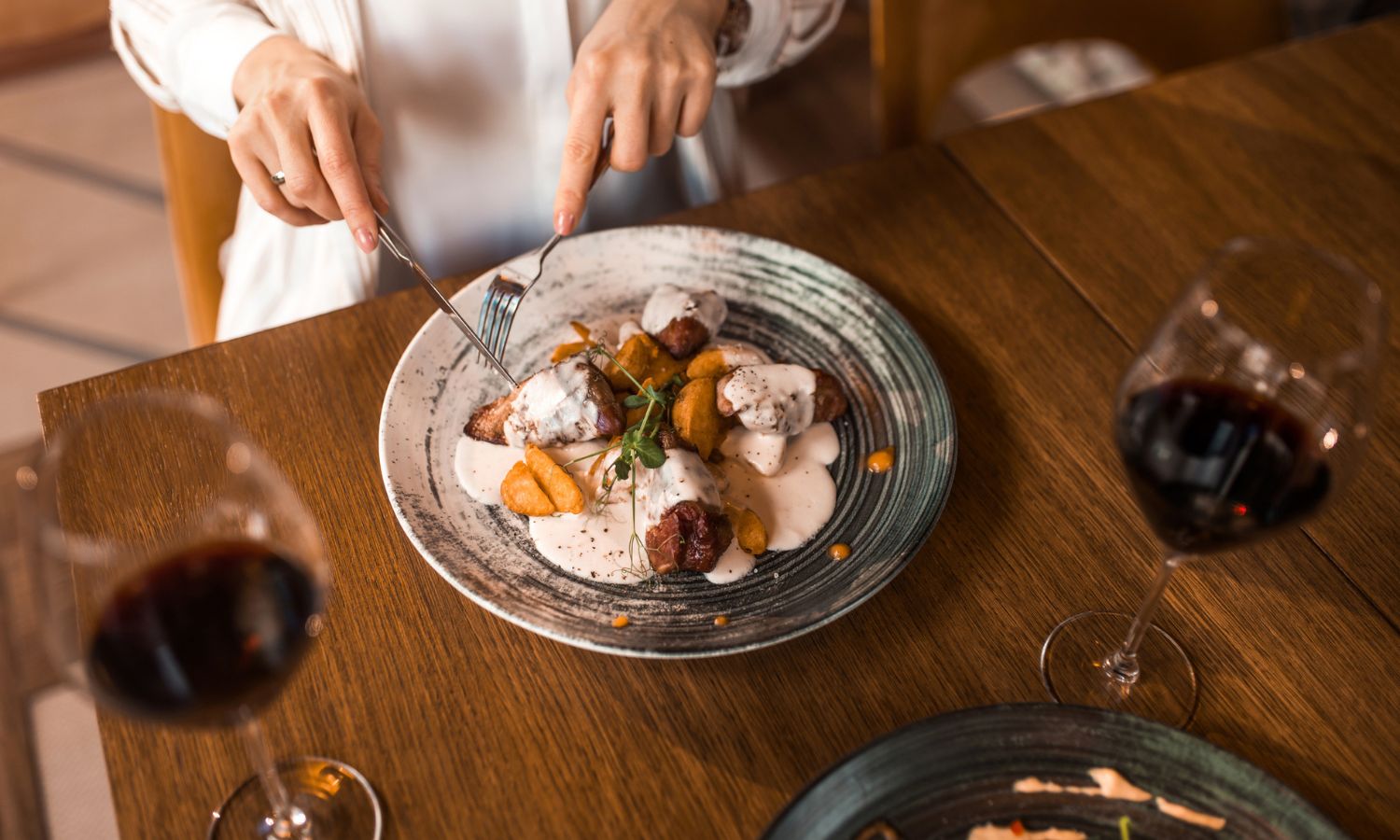You’re in a restaurant, and the waiter places a wine list so extensive it could double as a graphic novel. They loom nearby, casting a subtle but growing sense of urgency as your fingertips navigate the labyrinth of wine sections: red, white, sparkling, rosé, and more.
The waiter’s gaze conveys impatience as if they have a pressing matter to attend to. In a moment of sheer panic, you hastily opt for a chardonnay. “Excellent choice,” they declare briskly closing the tome of options and gliding over to attend another table.
Does this scenario sound all too familiar? Navigating wine lists can be a formidable challenge, particularly when confronted with a hefty leather-bound compendium of wines sourced from across the globe.
To help you order wine like a pro and, more importantly, give you the tools to read a wine list like a sommelier, we’ve tapped the expertise of some of Australia’s finest sommeliers. Among them is Polly Mackarel from Cirrus in Barangaroo, the recent recipient of Australia’s Wine List of the Year and the coveted Judy Hirst Award, shared with Nick Hildebrandt.
Additionally, Chris Walker from Cru Bar + Cellar in Brisbane, the previous year’s winner of Australia’s Wine List of the Year Award and this year’s recipient of Australia’s Best Sparkling List, will share his insights.
Karen Gough of Settler’s Tavern in Margaret River took home the gong for Australia’s Best Restaurant Wine List – Country, Alex McPherson at SK Steak and Oyster also took home the awards for Australia’s Best Listing of USA Wines, and Australia’s Best Listing of QLD Wines.
And last but certainly not least, Bridget Raffal, hailing from Where’s Nick, is honoured as Australia’s Best Wine Bar List.
With their collective expertise, we’ll unravel the mysteries of navigating a wine list and provide you with the essential knowledge to decode it like a pro.

Where Do I Start With a Wine List?
According to Walker, engaging the sommelier is the best place to start.
“The beginning of the drinks journey is different for every venue,” says Walker. “Sitting in the sun calls for sparkling, fino sherry or a beer, then white or rosé, but a subtly lit dining room is more suited to starting with a martini and leading into burgundy. Honestly, think about what you feel like and what you like. It is always best to start out with something that sparks joy.”
If you’re after something easy and classic to start, McPherson says nothing sets the tone of the meal to come as much as a beautiful glass or bottle of Champagne.
“While everyone is familiar with the big-name brands, don’t be afraid to try a grower champagne from a small producer (who ‘grows’ his or her own grapes). There are some wonderful, individual expressions of Champagne out there.”
According to Mackarel, a good wine list has a thoughtful and logical structure. Some will display in grape varieties from lightest to more fuller-bodied, and some will group wines together under sections like “aromatic” or “full-bodied red”.
“Personally, I think any first choice in a great meal is an aperitif, something to sip on while you make your choices of food & wine,” said Mackarel. “A beer, negroni or sherry. My go-to is a glass of bubbles.
Then, choose the wine when your thirst is quenched and you know what you will eat. If you’re there for a good time AND a long time, think about choosing different bottles to go with each course.”

What Should I Be Looking For?
When perusing a wine list, there are several key elements to consider:
Representations of Styles: According to Walker, you should look for a wine list that showcases a diverse range of wine styles. This indicates that the establishment is attentive to catering to various preferences and provides options for different occasions and tastes.
Value at Each Price Point: A well-constructed wine list should offer value across different price ranges. This means that you should be able to find wines that fit your budget while still enjoying a quality selection.
Interesting Deep Dives into a Genre: Walker explains a sign of a passionate and knowledgeable team is a wine list that delves deeply into specific wine genres or regions. These in-depth explorations demonstrate a commitment to offering unique and exciting options for wine enthusiasts.
Skin Contact Wines: If you’re interested in skin contact wines, be sure to engage with the sommelier for recommendations. These wines can vary widely in style and complexity, from easy-drinking to challenging, so that expert guidance can enhance your experience.
Complementing the Menu: Consider the type of cuisine you’ll be enjoying. A well-curated wine list should complement the menu, so look for wines that pair well with the flavours and style of the dishes you plan to order. Light and delicate dishes call for wines with a similar profile, while rich, hearty meals benefit from more robustly flavoured wines.

Why are Wine Menus Complicated, and How Do I Gain Confidence in Choosing Wine?
Wine menus can sometimes appear complicated, but there are good reasons behind this complexity. These sommeliers shed light on the subject.
Complexity Signals Passion and Knowledge: When a wine menu seems intricate and detailed, it’s often a sign that the establishment’s team is passionate about wine and dedicated to sharing their expertise, says Walker.
For instance, a comprehensive list of German Rieslings in an otherwise straightforward menu is an invitation to engage with the wine team. If the list appears complicated, consider it an opportunity to explore and expand your wine knowledge. Don’t hesitate to ask for assistance, as sommeliers are there to guide you.
Be Open to Trying Something New: Wine lists often feature a variety of wines you may not recognize. Instead of feeling overwhelmed, Raffal suggests you embrace the opportunity to explore the world of wine. Here are some tips Raffal recommends keeping in your back pocket.
- Take note of wines you’ve enjoyed in the past and describe your preferences.
- Keep an open mind and view unfamiliar wines as a chance to discover something new.
- Be specific when communicating your tastes to the sommelier, as it helps them make suitable recommendations.
- Experiment with different wines to refine your palate and preferences over time. There’s no shortcut to becoming a wine connoisseur; it’s a learning process.
Assistance is Always Available: In the end, Mackarel says, asking for assistance is a sign of confidence, not weakness. Don’t be discouraged by the size of the list or the unfamiliar options. There’s always a knowledgeable sommelier on hand who is more than willing to provide recommendations.

Can I Actually Give Back a Wine I Don’t Like?
Everyone has been in that position where the sommelier pours a thimble of wine into a glass; you pick it up, swirl it around a few times, sip, and then nod. But have you ever wondered what would happen if you shook your head instead? Well, according to our expert panel of sommeliers, it’s not that easy, as the purpose of a tasting is typically to check for faults, not personal preferences. Here’s what the experts say:
Walker: “If you’re unsure about the wine you’re ordering, it’s advisable to ask for a brief summary from the sommelier. This can help avoid any uncomfortable situations. However, in most cases, if the wine is sound and not faulty, sending it back because you don’t like it is not a common practice. If you do wish to return it, the restaurant may choose to remove the wine from the table and bill, sell the remainder by the glass, or use it for staff training.”
Mackarel: “Typically, when you order a wine, the tasting is to check for faults, not to see if you personally like it. A faulty wine should be examined by the sommelier and replaced if necessary. The best way to determine if a wine is to your liking is to have a quick discussion with your sommelier before the bottle is opened.”
Gough: “It can be tricky, especially in regions where customers may have more specialized palates. If a customer, particularly a local or winemaker with a trained palate, detects even a minor fault in the wine, it is usually taken back. However, if a customer simply doesn’t like the wine, it can be challenging, but the wine is usually replaced, and they choose an alternative.”

Is There a Golden Rule I Should Memorise For Food Pairings?
Start with what you like: Walker emphasises that a great starting point for food pairings is to choose a wine you genuinely enjoy. If you love sparkling wines, you can be happy drinking them with most dishes. Constructing a meal around your preferred wine can lead to a delightful dining experience.
Match Flavor to Flavor or Weight to Weight: Mackarel suggests considering classic pairings like champagne and oysters, duck and pinot, or steak and shiraz. These combinations exist for a reason. In general, think about matching flavours or weights; for example, a citrus-driven, minerally Chablis can complement freshly shucked oysters with lemon.
Consider the Local and the Dish: Gough encourages patrons to consider both the local wine offerings and the flavours and body of the chosen dish. Some wines, like a big cabernet, may not pair well with certain foods, so it’s essential to think about the specific characteristics of the wine and the dish.
Regional Pairing and Flavor Harmony: Raffal introduces the concept that “things that grow together tend to go together.” For example, in Brittany, muscadet wine pairs beautifully with local oysters. Consider what the food naturally complements, such as fish and chips with fresh lemon, and choose a wine with complementary characteristics. While there are no strict rules, avoiding very tannic reds with oily fish and matching the intensity of flavours between the dish and the wine can guide your pairing decisions.
Related: Rising Temperatures Uncork New Challenges and Opportunities For Australia’s Wine Industry
Related: How to Store Red Wine in Your Home Because We Don’t All Have Cellars
Read more stories from The Latch and subscribe to our email newsletter.







